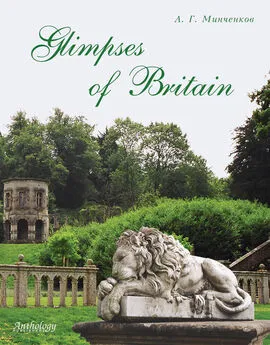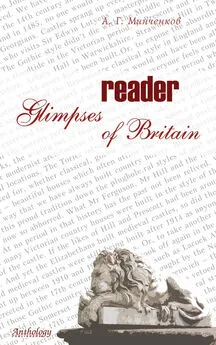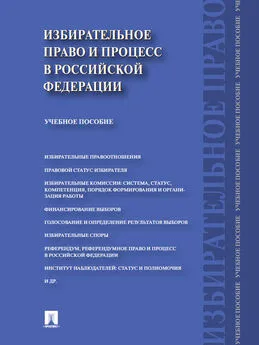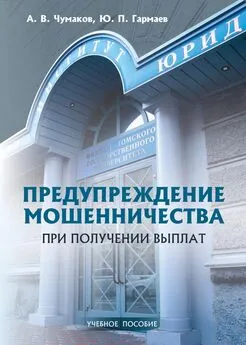Алексей Минченков - Glimpses of Britain. Учебное пособие
- Название:Glimpses of Britain. Учебное пособие
- Автор:
- Жанр:
- Издательство:Array Литагент «Антология»
- Год:2006
- Город:Санкт-Петербург
- ISBN:5-94962-114-X
- Рейтинг:
- Избранное:Добавить в избранное
-
Отзывы:
-
Ваша оценка:
Алексей Минченков - Glimpses of Britain. Учебное пособие краткое содержание
Пособие предназначено для студентов и школьников, занимающихся страноведением Великобритании, преподавателей, переводчиков и всех, кто интересуется историей, культурой и современной жизнью этой страны.
Glimpses of Britain. Учебное пособие - читать онлайн бесплатно ознакомительный отрывок
Интервал:
Закладка:
Alfred was succeeded by three strong kings who took up the task of creating and consolidating the new kingdom of England. His son Edward the Elder first reconquered the whole of East Anglia and the eastern Midlands and then, by 920, all the lands as far as the Peak District. During the reign of Alfred’s grandson Athelstan the Viking invasions renewed, with the aim of setting up a northern kingdom based in York. In 927 Athelstan defeated them and soon established himself as a single king ruling both north and south, in effect the first king of England as far as Northumbria. A single currency was introduced for the kingdom and many new laws were made. During the reign of Edgar (959–975) the Roman-style ceremony of crowning and anointing the king appeared. In this ceremony it wasn’t the crowning by the bishop which was the most important act but the anointing of the king with holy oil in the same way as priests were anointed. This act set him apart from ordinary men, making him Lord-anointed. Yet, in spite of the king’s enhanced status and the mystique surrounding the monarchy, one of the fundamental principles of Anglo-Saxon society, which was to run down through the centuries, was that effective government should be based on a dialogue between the ruler and the ruled. At the top level it was reflected in the fact that Anglo-Saxon kings were always elected, from a member of the royal dynasty. That was the task of the great magnates, both nobility and upper clergy, who made up the king’s council called Witenagemot (from witena : Old English genitive plural of wita ‘councillor’ + gemot ‘meeting’). Also, all the English counties and shires took shape during this period; they were divided into smaller units called hundreds, each one of which had a kind of court (moot), where justice was administered by the king’s representative together with those who lived in the area.
Another fundamental principle of Anglo-Saxon England, which was to be important for the future, was that the kings were expected to live ‘of their own’, that is from the income received from the vast estates which they held as the country’s richest landowner. At the same time a system of universal taxation gradually began. This was the direct result of the attacks by the Norsemen that resumed under the weak king Ethelred, who decided to buy off the invaders with large sums of money called ‘Dane-geld’. Everyone had to contribute towards this; the money was collected from all over the country in carts and delivered to the king’s treasury at Winchester, the capital. Although these taxes were the result of a crisis, they set a precedent: everyone should be taxed to meet certain common needs such as war. Yet, since the kings were expected to live ‘of their own’, taxation was to be exceptional for many centuries, and was perceived as such by the people.
In the early 11th century the country was scourged by a new wave of Vikings, the Norsemen.
In 1009 Sweyn, king of Denmark, landed at the head of a vast army and by 1013 all the nation regarded him as full king. Ethelred fled into exile. But then Sweyn died and in the confused period that followed Ethelred died too. His son’s reign lasted for just seven months, and after his death the Witenagemot elected Sweyn’s son, Canute, to be king (1016–1035). Thus England entered the 11th century as part of a huge Scandinavian empire which embraced Denmark, Sweden and part of Norway. Canute, who had begun his life as a bloodthirsty warrior, transformed himself into an ideal Anglo-Saxon king. His greatest innovation was to divide the entire country into four great earldoms each presided over by an earl.
In 1042 Ethelred’s son Edward came to the throne as Edward II, often referred to as Edward the Confessor. He was a competent and wise monarch, ruling England for twenty-four years and leaving a united country to his successor. Edward the Confessor was a deeply pious man, and it was in his reign that Westminster Abbey was constructed. On his deathbed he nominated his brother-in-law Harold, Earl of Wessex, as his heir. After Edward’s death Harold was duly elected by the Witenagemot. He was a man of strong character and a brilliant soldier, so everything seemed to indicate that the Anglo-Saxon kingdom would continue as before. However, there was another claimant to the throne. He was William, Duke of Normandy (a duchy in Northern France). William’s claim to the Anglo-Saxon throne was in fact extremely remote, he was just a great-nephew of Edward’s queen, but he maintained that Edward himself had promised him the crown as early as in 1051, and moreover Harold had sworn allegiance to him as his future king during his visit to Normandy in 1064. The latter visit is surrounded by mystery and there is nothing to prove William’s claims beyond his assertion. Anyway, in the second half of the 11th century the Normans had a vitality that other peoples lacked. William was also a master of propaganda and diplomacy. He succeeded in persuading both the Holy Roman Emperor and the pope of the justice of his cause. Harold, on the other hand, was at a disadvantage, for, being threatened by the Norwegians and his own brother Tostig in the north as well as the Normans in the south, he had to fight on two fronts. When the Norwegians were defeated and Harold faced William in the battle of Hastings, which took place on October 14 1066, his army was exhausted. During the battle Harold perished, felled by a mounted knight with a sword. His army fled. The battle was to be an opening chapter in the story of the death of Anglo-Saxon England. Soon the whole of the south-east surrendered to William. On Christmas Day William was anointed and crowned in Westminster Abbey as William I (1066–1087). Although the conquest of England wasn’t achieved overnight, within five years, by 1071, William’s ruthless and efficient military machine had made the conquest an irreversible fact.
There is an interesting and unique historical document telling the history of the Norman Conquest, which is at the same time an example of political propaganda of those times. The Bayeux Tapestry was made between 1070 and 1080, commissioned by William’s half-brother, Odo of Bayeux. It is 70 metres long and 50 centimetres wide. The embroidered tapestry shows the events from the times of Edward the Confessor to the death of Harold. The scenes include, for example, Harold swearing an oath to William in Normandy, Harold breaking the oath by accepting the crown on Edward’s death, with a comet appearing in the sky foreboding disaster for the oath-breaker (the comet actually appeared on the night of 24 April 1066); William landing in England and the battle of Hastings in action. The underlying message of the tapestry is that perjury draws divine retribution on the person committing it: the defeat and death of Harold are presented as Acts of God.
The House of Normandy
As soon as it became clear that the king’s initial desire to work with the old Anglo-Saxon aristocracy had failed, he set out to create a new йlite that would be loyal to him and ensure his position as king of England. That was secured by two things: castles, and knights to man them. The most famous of all the castles was the Tower of London. William I organized the government of England on the system that had been successful in Normandy – the feudal system based on the ownership of land. He granted lands confiscated from the defeated aristocracy to 170 of his followers who became thereby his tenants-in-chief. The grants of land were usually scattered through several shires. Collectively each group of lands was called an honour and each honour consisted of several smaller units called manors, divided among the 5,000 knights who had fought at Hastings. A knight had to swear loyalty to his lord. Each tenant-in-chief had 2 groups of knights: one consisting of those who were permanently part of his household and a second one including those who came in return for land. The lords themselves had to swear loyalty to the king and to supply knights for his service. The common people belonged to the knight on whose manor they lived. They had to serve as farm-workers but not as soldiers. There was also a small class of freemen, who didn’t have to work on the knight’s farm. William was a strong king and the system worked. The trouble was that under a weaker ruler the system could break down, leading to private castles and armies.

The White Tower in the Tower of London
The same revolution was applied to the Anglo-Saxon church. In Normandy William controlled all the appointments of bishops and abbots, filling them with his own friends and relations. Bishops and abbots from before 1066 either died or were deposed. They were replaced by Normans, and had to render the king rent in the form of armed knights. Together the tenants-in-chief, bishops and abbots made up the new ruling class, for the higher clergy, being educated, were essential for the running of the government. In these changes William was aided by a new archbishop of Canterbury, Lanfranc. Both believed that priests should be celibate. More significant for the future was the creation of special courts to deal with church cases only.
All the lords had the right to attend the king’s council and it was his duty to ask their advice. William held council meetings nearly every day, wherever he happened to be. Three times a year he held a ceremonial council for Christian feasts and wore his crown: in Winchester for Easter, in London for Whitsun and in Gloucester for Christmas. Then every lord had to attend.
Winchester castle was still the seat of Government. Here William set up his government office, which controlled the collection of taxes and kept account of all expenses. From this office men were sent out in 1086 to make a detailed record of all the wealth of England, for William, fearing invasion from Denmark, wanted to extract the maximum in taxation. The result was the Domesday Book, which gives us a complete description of the country. The book occupies 400 double-sided pages and paints a picture of a country where virtually the entire population was engaged in agriculture with little or no industry or commerce, and few towns.
 William’s reign saw a wave of new building in the beautiful style called Norman or Romanesque. The Romanesque style was fully developed by about 1100, becoming the accepted style for church buildings throughout Europe, with marked regional variations. In England, soon after the Norman Conquest work began on the Cathedrals of Canterbury, Lincoln and Winchester [12] , and the churches of St. Albans, Ely and Worcester. However, only parts of these buildings have survived: they were all largely rebuilt in the 12th – 14th centuries. The finest Norman building to survive in England is Durham Cathedral, begun in 1093 and completed in 1133. [7] The style made use of massively thick walls, huge columns and lofty vaults. There were small windows and doors. The round arch became established as the basis of the church interior. [9] Some of the churches were indeed very ornate, with decorated pillars and carved doorways.
William’s reign saw a wave of new building in the beautiful style called Norman or Romanesque. The Romanesque style was fully developed by about 1100, becoming the accepted style for church buildings throughout Europe, with marked regional variations. In England, soon after the Norman Conquest work began on the Cathedrals of Canterbury, Lincoln and Winchester [12] , and the churches of St. Albans, Ely and Worcester. However, only parts of these buildings have survived: they were all largely rebuilt in the 12th – 14th centuries. The finest Norman building to survive in England is Durham Cathedral, begun in 1093 and completed in 1133. [7] The style made use of massively thick walls, huge columns and lofty vaults. There were small windows and doors. The round arch became established as the basis of the church interior. [9] Some of the churches were indeed very ornate, with decorated pillars and carved doorways.
As for domestic architecture, there were manor houses and castles. In early Norman England the hall, together with a few out-buildings about a courtyard constituted the entire accommodation of the manor house. The first castles had a mound or motte [6] (in modern England remains of more than 3,000 Norman mounds can be found) with a single defensive four-storey tower and a bailey, that is a fortified outer wall initially made of wood and later of stone. The most famous of the early Norman towers is the White Tower of London begun in 1078. Slightly later came circular shell-keeps like that at Windsor Castle. In the mid-12th century this style changed under the influence of the Crusades. A fine example of the new style is Conisborough Castle built about 1180 (used as a setting for the film based on Ivanhoe by W.Scott). The tower or the keep was retained as a lordly residence. [14] This was surrounded with a stone curtain wall with solid half-round towers along its length. Rings of concentric defenses were to be the future of the castle form. [13] By the second half of the 12th century the castle had already become primarily a domestic residence, but with built-in precautions for protection against social unrest.
Читать дальшеИнтервал:
Закладка:










